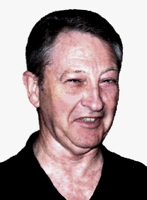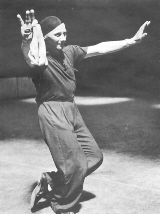
|
Folk Dance Federation of California, South, Inc.
Real vs. Choreographed |

|
CLICK AN IMAGE TO ENLARGE
The cussin' and discussin' of "real" versus "choreographed" dances has gone on for as long as I've been folk dancing. I can't resist adding my own concerns about this ever-lasting issue.
It might help to take a look at how the whole folk dance "movement" started and what issues shaped recreational folk dance as we know it.
At least as far as California in particular, and the country in general, is concerned, trace it back to the Stockton Folk Dance Camp, the grand-daddy of them all. When Lawton Harris started the camp back in 1948, he set down a series of rules and conditions that put several restraints and requirements on teachers. Some of them sound pretty strange now and were certainly not conducive to taking a "folkloric" approach to the dance. I don't know what they all were, but a couple I can recall: "The dance must not have been taught anywhere else" and "There must be no variations to the choreography."
There were others, but just these two tended to put a rigid and artificial face on the folk dances coming from the camp, which for a long time, was THE fountainhead of material for the recreational folk dance community. Lawton Harris was not a folklorist; his concern was in creating a dance form in which everyone would dance exactly the same thing everywhere.
 One of the first teachers Lawton engaged was well-known character dance teacher, Anatol Joukowsky, "Mr. J." to everyone who knew him (photo at left). Mr. J was a charming gentleman and a great teacher of very complicated choreographies — most of which turned out to be far from the truth. Most bore little if any resemblance of the true folk dances from which they were supposedly taken. Vrtielka, for instance, was supposed to be from Novy Zamky in Slovakia. My contact from Novy Zamky says there is no such word in their language, the music does not resemble anything she ever heard, and the dance does not resemble anything she ever saw.
One of the first teachers Lawton engaged was well-known character dance teacher, Anatol Joukowsky, "Mr. J." to everyone who knew him (photo at left). Mr. J was a charming gentleman and a great teacher of very complicated choreographies — most of which turned out to be far from the truth. Most bore little if any resemblance of the true folk dances from which they were supposedly taken. Vrtielka, for instance, was supposed to be from Novy Zamky in Slovakia. My contact from Novy Zamky says there is no such word in their language, the music does not resemble anything she ever heard, and the dance does not resemble anything she ever saw.
So Mr. J was creating dances from his own theatrical dance background and those dances set the example for other dance teachers to follow. Ned and Marion Gault choreographed and presented several lovely tangos, all beautifully choreographed, many still in the repertoire. Others followed as time went on and the mindset became one of collecting as many dances as one could as though the one who died with the most dances won. The folk dance repertoire became "a mile wide and an inch deep." Folk dancers prided themselves on how many dances they could learn and remember and folk dance became no different from the round dance, with a "dance of the month" mentality.
Even Dick Crum commented several times, in his unique fashion, that the folk dancers, and often the folk dance sources, "had their way" with "real" dances, changing their character into something that they were not, with no concern for the dances' traditions. Tony Shay comments in his excellent book about the influence of state-mandated choreographies that made spectacle out of village dance and gave us many of the folk dances we now have in the repertoire.
The great loss is the failure of teachers to instill the more intellectual elements of folk dance — the interest in the related folklore and history of the dance and of those who created and the dances and considered the dance to be theirs. There was no effort to teach technique; there was little or no effort to relate the dance to the music and certainly no effort to relate to one's partner. The folk dancers themselves are partly to blame for that, demanding more and more "new" material to add to their already extensive repertoire.
Every once in a while, a folk dancer would get a glimmer that all this dance material was not "the real deal." I recall one gentleman in class (at Stockton) looking at a dance being demonstrated by a teacher, and mumbling, "I think we're being sold a bill of goods." Ah — enlightenment!
As time passed folk dance began to splinter into specialized groups (losing many dance forms in the process) and many dancers became more serious about the dance. They began to seriously study the cultures from which the dances came. They traveled, learned the language, the music, the instruments, the folklore, the cultural personality. Most notable are the Balkan, Scandinavian, and Hungarian dance communities, whose dance repertoire is far smaller than the general folk dance community — and far more authentic and advanced.
The issue then becomes, for those dancers, that they have literally exited from the recreational folk dance community, often without realizing it, and are sadly disappointed when they attempt to re-enter it. Imagine coming from spending years learning the finer points of a very difficult Transylvanian/Hungarian couple dance and being limited to an evening of little choreographed dances that are danced robotically by folk dancers who have no knowledge or interest in anything about the dance other than its choreography.
No wonder folk dance has lost its bloom. It aged without maturing. It placed quantity ahead of quality. It placed choreography ahead of ethnology. It placed regurgitation ahead of improvisation. It placed memorization ahead of technique.
Perhaps the question of "real" versus "choreographed" is not the concern; perhaps we should consider whether folk dance, real or not, should continue as it has until the very end. Is it possible that the last folk dancer is already old?
My personal opinion is that folk dance has so much to tell us about the artistic urge that is so ingrained in the human condition that we owe it every effort to learn. Folk dance is generally considered to be the dance of the peasants, the lower classes, who lived a life of drudgery and unending toil, yet they had the inclination and the talent to create exquisite cultural treasures of music and dance and costume and folk arts. They were real people and they deserve the respect of serious study.
To get back on topic: "choreographed" dances need to be recognized for what they are and folk dancers need to decide what is more important. Do we wish to be "a mile wide and an inch deep" or will we go in search of the answer to "why do people dance the way they do?"
Used with permission of the author.